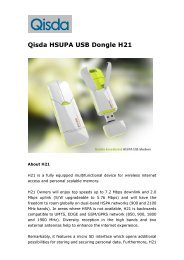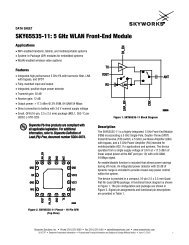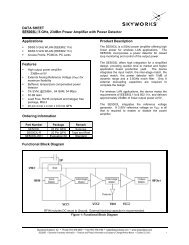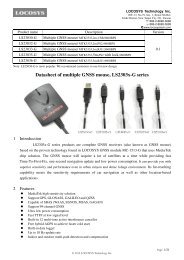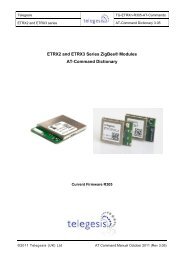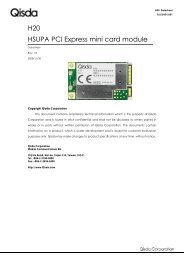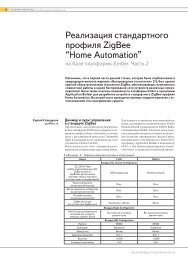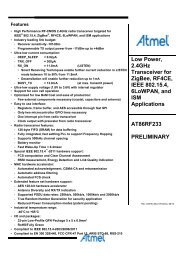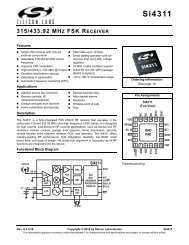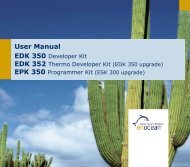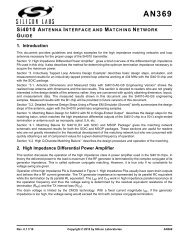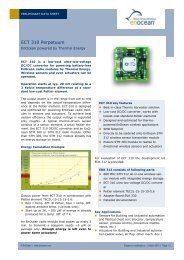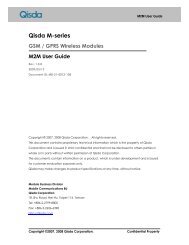AT Command Reference Guide for EDGE Wireless ... - wless.ru
AT Command Reference Guide for EDGE Wireless ... - wless.ru
AT Command Reference Guide for EDGE Wireless ... - wless.ru
You also want an ePaper? Increase the reach of your titles
YUMPU automatically turns print PDFs into web optimized ePapers that Google loves.
Chapter 4 – Serial Interface Control <strong>Command</strong>s<br />
4.4 <strong>AT</strong>&S Set Circuit DSR Function Mode<br />
Description:<br />
Exec <strong>Command</strong>:<br />
Response:<br />
The <strong>AT</strong>&S command determines how the TA sets circuit 107 Data Set Ready (DSR)<br />
depending on the communication state of the TA interfacing TE.<br />
<strong>AT</strong>&S<br />
OK<br />
Parameter Description:<br />
<br />
0 DSR line is always ON. Default.<br />
1 TA in command mode: DSR is OFF.<br />
TA in data mode: DSR is ON.<br />
4.5 <strong>AT</strong>E Enable <strong>Command</strong> Echo<br />
Description:<br />
The <strong>AT</strong>E command determines whether or not the TA echoes characters received from<br />
TE during command state.<br />
Exec <strong>Command</strong>: <strong>AT</strong>E[]<br />
Response:<br />
OK<br />
Parameter Description:<br />
<br />
0 Echo mode off. Default.<br />
1 Echo mode on<br />
Note: In case of using the command without parameter, is set to 0.<br />
4.6 <strong>AT</strong>+ICF Serial Interface Character Framing<br />
Description:<br />
Test <strong>Command</strong> Syntax: <strong>AT</strong>+ICF=<br />
Response(s):<br />
Read <strong>Command</strong> Syntax: <strong>AT</strong>+ICF<br />
Response(s):<br />
The command <strong>AT</strong>+ICF controls the serial interface character framing <strong>for</strong>mat and parity<br />
used <strong>for</strong> receiving and transmitting. The following settings are supported:<br />
• 7 bits, even parity, 1 stop bit (<strong>AT</strong>+ICF=5,1)<br />
• 7 bits, odd parity, 1 stop bit (<strong>AT</strong>+ICF=5,0)<br />
• 8 bits, even parity, 1 stop bit (<strong>AT</strong>+ICF=2,1)<br />
• 8 bits, no parity, 1 stop bit (<strong>AT</strong>+ICF=3)<br />
• 8 bits, odd parity, 1 stop bit (<strong>AT</strong>+ICF=2,0)<br />
• 8 bits, no parity, 2 stop bits (<strong>AT</strong>+ICF=1)<br />
+ICF: (list of supported s), (list of supported s)<br />
OK<br />
+ICF: [, ]<br />
OK<br />
Write <strong>Command</strong> Syntax: <strong>AT</strong>+ICF=[][, ]<br />
Response(s):<br />
OK<br />
ERROR<br />
Parameter Descriptions:<br />
<br />
Specifies the character <strong>for</strong>mat used <strong>for</strong> receiving and transmitting.<br />
1 8 data 0 parity 2 stop<br />
2 8 data 1 parity 1 stop<br />
3 8 data 0 parity 1 stop<br />
5 7 data 1 parity 1 stop<br />
<br />
Specifies the method of calculating the parity bit, if a parity bit is supported by .<br />
If does not support parity, this parameter has to be omitted.<br />
0 odd<br />
1 even<br />
Notes:<br />
• If <strong>AT</strong>+ICF modes 7E1 or 7O1 are set, the parity bit will by default not be transmitted over the air. If the remote<br />
party expects the parity bit to be transmitted, additional settings are required via <strong>AT</strong>^STPB.<br />
• When using a bit rate of 300 bps there must be a delay of 500ms be<strong>for</strong>e entering the next command. At bit<br />
rates of 1200 bps the delay must be 300ms. For higher bit rates use of the default delay is sufficient.<br />
• The Multi-Tech wireless modem’s autobaud feature detects the bit rate currently used by the TE. However,<br />
this detection suffers some limitations described in Section 4.9.1, Autobauding. If autobauding is enabled, the<br />
<strong>AT</strong>+ICF read command does not show the current character framing, but the character framing that will be<br />
used when autobauding is disabled.<br />
Multi-Tech Systems, Inc. <strong>AT</strong> <strong>Command</strong>s <strong>for</strong> <strong>EDGE</strong> Modems (S000371B) 52



